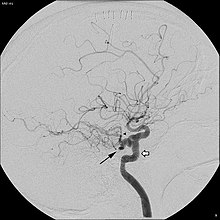
The trigeminal artery is an artery that supplies the basilar artery with blood during human embryonic development. Normally, the trigeminal artery involutes after the formation of the posterior communicating artery. However, in some cases, the artery persists into adulthood and can cause medical complications, including intracranial aneurysms.
Normal development
The trigeminal artery arises from the primitive internal carotid artery during development, when the embryo is approximately 6 weeks old. The trigeminal artery then anastomoses with the basilar artery. At this point in development, the trigeminal artery serves as the main blood supply for the hindbrain, as other vessels in the region have yet to mature. As the internal carotid artery branches more caudally to form the posterior communicating artery, the trigeminal artery becomes less important in supplying blood and ultimately involutes. The time period from the initial development of the artery to its ultimate involution is only 7 to 10 days; if the artery has not involuted at the end of this period it persists into adulthood.
Persistent trigeminal artery
In around 0.1 to 0.6% of individuals, as sampled by magnetic resonance angiography, the trigeminal artery fails to involute and remains in the adult brain, in a condition called persistent trigeminal artery. This condition is more common in women than in men, with approximately 1.8 times as many women having the condition. Knowledge of a persistent trigeminal artery may be important in certain brain surgeries, as the condition is rare and an accidental cut to the artery could lead to hemorrhage. Although the discovery of a persistent trigeminal artery is sometimes an incidental finding, its presence is also associated with various pathological conditions, and must therefore be considered carefully when diagnosing these conditions.
Associated conditions
A persistent trigeminal artery is associated with an increased risk of aneurysm, though some studies have suggested that this finding may be an effect of selection bias, as most individuals do not undergo the tests necessary to identify the condition. Persistent trigeminal artery has been identified as a rare cause of trigeminal neuralgia, with 2.2% prevalence of persistent trigeminal artery among trigeminal neuralgia patients. Surgery to move the persistent trigeminal artery away from the trigeminal nerve has been successful in treating the trigeminal neuralgia in some cases. In some cases, presence of a persistent trigeminal artery concurs with hypoplasia of the basilar artery, in which case the internal carotid artery is responsible for most blood flow to the upper pons, cerebellum, midbrain, and parts of the temporal and occipital lobes, meaning that anything disrupting blood flow in the internal carotid artery could lead to ischemia in these regions. In addition, persistent trigeminal artery has been associated with vertebrobasilar insufficiency, brainstem ischemia, and carotid cavernous fistulae.
References
- ^ Simon J. Dimmick and Kenneth C. Faulder. "Normal Variants of the Cerebral Circulation at Multidetector CT Angiography". RadioGraphics (2009) 29: 1036.
- ^ Waleed Azab, Johnny Delashaw, and Mohammed Mohammed. "Persistent Primitive Trigeminal Artery: A Review." Turkish Neurosurgery (2012) 22:400.
- ^ Stephan Meckel, Bjoern Spittau & William McAuliffe. "The persistent trigeminal artery: development, imaging anatomy, variants, and associated vascular pathologies." Neuroradiology (2013) 55:5–16.
- William S. Fields. "The significance of persistent trigeminal artery: Carotid-basilar anastomosis. Radiology (1968) 91: 1096-1101.
- Ljiljana Vasovic, et al. "Trigeminal artery: a review of normal and pathological features." Child's Nervous System (2012) 28: 33-46.
- Eri O'uchi and Toshihiro O'uchi. "Persistent primitive trigeminal arteries (PTA) and its variant (PTAV): analysis of 103 cases detected in 16,415 cases of MRA over 3 years. Interventional Neuroradiology (2010) 52:1111-1119.
- Alejandro M. Russo and Maria C. Sienra. "Persistent trigeminal artery: case report". International Journal of Anatomical Variations (2011) 4: 157-160.
- Licia Pereira, et al. "Persistent trigeminal artery: Angio-tomography and angio-magnetic resonance finding". Arquivos de Neuro-Psiquiatria (2009) 67:882-885.
- Chang Kyu Park, et al. "Trigeminal neuralgia caused by persistent primitive trigeminal artery." Journal of Korean Neurosurgery Society (2014) 56: 278-280.
- Gabriel Alcalá-Cerra, R Shane Tubbs, and Lucía M Niño-Hernández. "Anatomical features and clinical relevance of a persistent trigeminal artery". Surgical Neurology International (2012) 3:111.